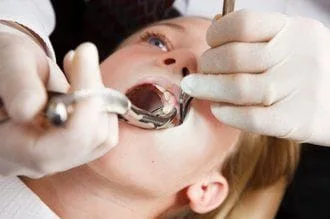Extractions

Extractions
When teeth become extremely decayed, impacted, crowded, there has been a dental trauma, or significant bone loss has occurred, a tooth may need to be extracted. Extractions typically occur when a tooth is no longer viable for restoration. There are two types of extractions, simple extractions and surgical extractions.
Simple extractions are commonly performed in this office and involve local anesthetic, typically both topical anesthetic and an injection are used. During a simple extraction one or more teeth are removed by using instruments called elevators to loosen the tooth before it is removed using pickups. Gauze will be placed at the end of the extraction and extra gauze will be given along with at home care instructions. Gauze should be changed out every few minutes for the first 30 minutes with changes being closer to 20 minutes when bleeding slows. If bleeding continues longer than 24 hours or is particularly severe your dentist should be notified and the bleeding should receive attention.
Surgical extractions occur when an incision into the connective tissue (gums) surrounding the tooth is necessary and typically occur when a tooth needs to be extracted but is still partially or completely under the gum line. This type of extraction is common in the removal of wisdom teeth.
Sometimes a tooth may not be able to be removed in one piece due to fractures or breakage. If this is necessary, such as with an impacted tooth, the tooth will be broken into multiple pieces for extraction. Occasionally the top of a tooth will break off and the roots will need to be extracted. Typically even if there are multiple pieces they will all be extracted in one appointment.
Wisdom Teeth Extractions
Wisdom teeth extractions are not performed at this office but if they are recommended a referral will be given.
Wisdom teeth extractions are a fairly common procedure. Wisdom teeth often cause problems as they are trying to protrude through the gums. When a wisdom tooth is impacted, it means the tooth is coming in at an angle and not straight through the gum line. The tooth can come in unevenly or may only emerge partially, both of which may cause pain or the development of decay. Further dental issues such as crowding of the teeth can also occur.
When a wisdom tooth only emerges partially a flap of skin, called an operculum, may form over the tooth. This can make the tooth hard to clean, and pieces of food may be caught under the skin. This makes it easy for an infection, called pericoronitis, to develop. It will usually go away on its own, but it causes swelling and pain in the area. A cavity may also form as a result of the stuck food causing decay of the tooth.
Wisdom extractions can range from a single tooth, to removing all four teeth at once. Based on the preference of the doctor and/or the patient, a local anesthetic could be used to numb the areas where the teeth will be extracted. Others will prefer to go under a general anesthetic so that they will be sedated during the procedure. Please see "Before Anesthetic" under surgical instructions on patient resources for information on what to do before going under Intravenous sedation.
The gum tissue around the wisdom tooth is cut open to reveal the tooth. The tooth is loosened by gripping it tightly and wiggling it back and forth until it can be lifted out of the gums. Sometimes a tooth may be impacted so tightly that it cannot be simply lifted out of the gums. In cases like this the tooth will be broken up into pieces first before being removed. Depending on the incision and extraction site, sutures may be needed to close the area. Soluble sutures are the best option, which will dissolve on their own.
After the surgery you will need to rest. You need to be driven home by a friend or family member due to the effects of the anesthesia. You can expect for the extraction site to bleed for a little while after the surgery. Gauze will be applied at the completion of the surgery, and you will need to change it when it becomes soaked. If bleeding continues for longer than 24 hours you should call your dentist. Rest when you return home, but do not lie flat. This could prolong the bleeding. Prop your head up on a pillow when lying down. Your dentist will prescribe you pain medication, so if you become sore take as directed. You can also use an ice pack for the pain and to decrease inflammation. Your dentist may also provide you with a cleaning solution to clean the extraction site.
You will be limited to soft foods for a few days after your surgery. Some recommended foods are:
- Gelatin
- Pudding
- Yogurt
- Mashed Potatoes
- Ice Cream
- Thin Soups
- ...and other food you can eat without chewing.
When drinking, make sure you do not use a straw. The sucking motion can loosen your sutures and slow the clotting process. The same goes for smoking. If you have prolonged pain, bleeding, irritation, or don't feel that the extraction site is healing properly call your dentist for a follow up.

